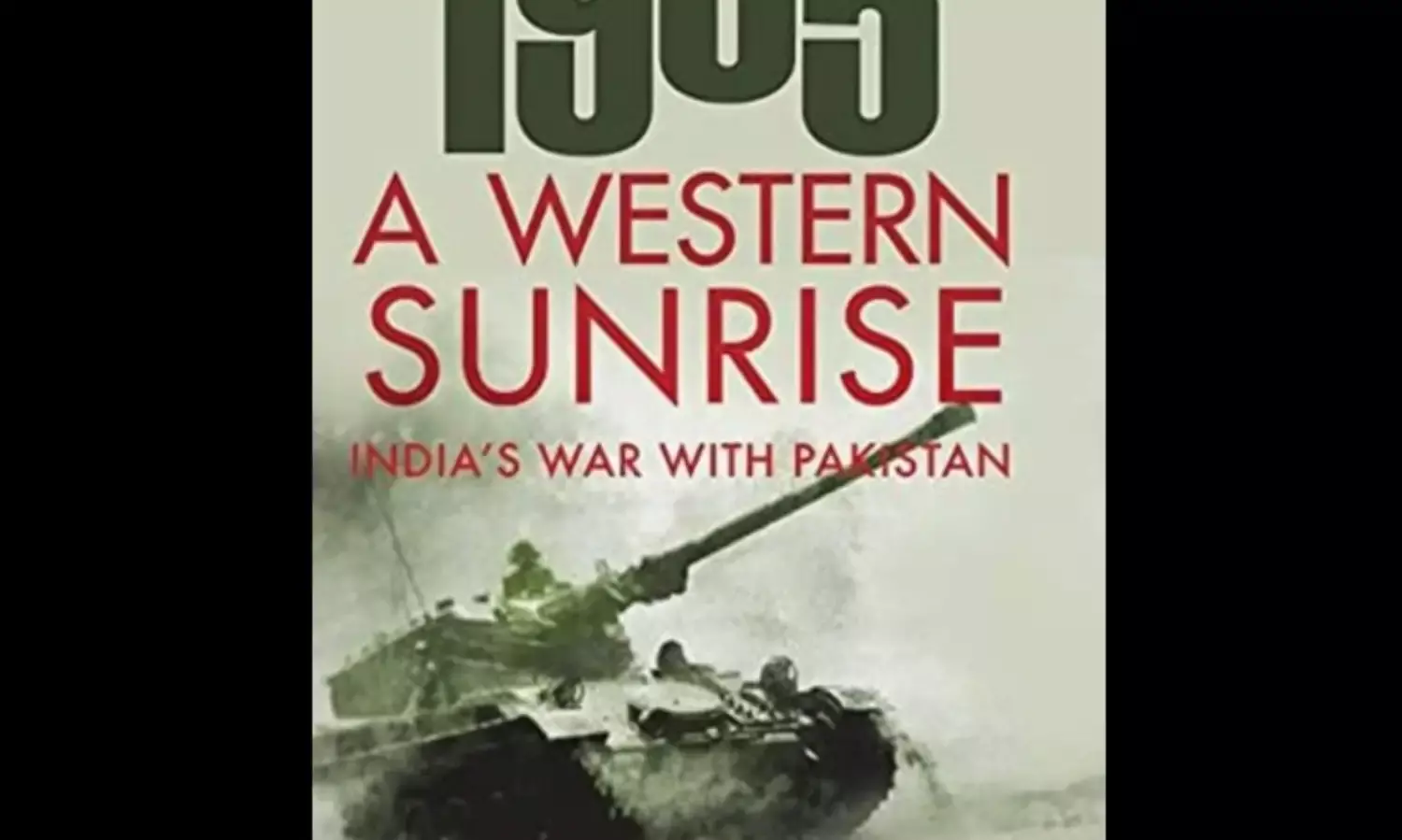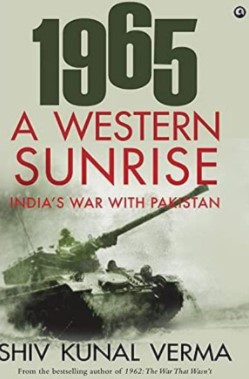1965: A Western Sunrise is a Masterpiece in Military History
By far the most eloquent account of the 1965 war

1965: A Western Sunrise is yet another masterpiece among the galaxy of books on military history being brought out every second or third year by Shiv Kunal Verma, the Dehra Dun born acclaimed military historian. It is by far the most eloquent account of the 1965 War and “sets the bar in military writing,” say some of the critics.
“While India was still licking its wounds from the disastrous 1962 War against the Chinese, a belligerent and conceited Pakistan decided to wrest Kashmir from India. To test the waters, it launched its initial military probes into the Rann of Kutch between February and May of 1965; India strongly responded. However, by the end of July, India yielded to the dictates of the UN, and stood down the troops it had mobilized in the Punjab and Kargil sectors in response to the Rann of Kutch ‘skirmishes’.
“Pakistan then launched Operation Gibraltar in Kashmir in August 1965 imagining it to be its Brahmastra. It deployed nearly 12,000 trained Mujahids in multiple groups, each named after historical plunderers of the sub-continent. Confident that it had the superior armour like M-47 and M-48 Patton tanks and better fighter planes such as F-86 Sabres and F-104 Starfighters, and better submarines than India, the Pakistanis expected that in the event of an expanded war, the Indians would collapse just as they had against China in NEFA three years previously,” Verma writes in the Introduction.
“But contrary to the Pakistan’s expectations, India firmly repulsed the attack and cut off its entry and exit points into the Kashmir Valley by capturing the Haji Pir Bulge. Operation Gibraltar thus fizzled out. Stung by its reverses, Pakistan then launched Operation Grand Slam in September 1965 in Chhamb and Jaurian. The resultant Indian counter-attack saw the focus shift to various other sectors – Lahore, Barki, Kasur [Khem Karan], Fazilka, Sialkot, and Barmer – on the international border. With the rival Air Force formations getting involved almost simultaneously, the Armed ‘Skirmishes’ turned into a full-scale war.”
Continuing the narrative, Verma writes, “As they had in 1962, the junior officers and men of the Indian Armed Forces admirably acquitted themselves despite the on-the-fly reorganization of Forces, lack of intelligence, obsolete equipment, and lacklustre military leadership. What could have ended in victory instead culminated in a stalemate. Official Indian figures put the total number of causalities at 12,714, out of which 2,763 were killed, 8,444 wounded, and 1,507 missing. An estimated 2,000 casualties occurred after the Ceasefire, raising questions about the effectiveness of the UN as a global Peacekeeping body. Neutral observers put the Pakistani deaths at over 5,000.
“The conflict ended when the Tashkent Agreement was signed by the Indian Prime Minister Lal Bahadur Shastri and Pakistan’s President Ayub Khan on 10 January 1966, agreeing to observe the Ceasefire Lines and withdraw their respective Armed personnel to positions that they had held before 5 August 1965.”
However, the Tashkent agreement was not without an accompanying tragedy: within hours of its signing, India’s diminutive Prime Minister Lal Bahadur Shastri suffered a fatal heart attack.
Scion of an Army family, Shiv Kunal together with his better half Dipti Bhalla enjoys the unique distinction of having worked in conjunction with all three Wings of the Indian Armed Forces over the past two-and-a-half decades. They had then flown extensively for the Indian Air Force, and in the process made Salt of the Earth (1993) and Aakash Yodha (2001), two of the much talked about short films.
All that had given them a ringside view of military matters. Thus their later foray into the production of short films such as Naval Dimension and The Kargil War turned out to be a seamless transition. No wonder then that their subsequent documentary The Standard Bearers on the National Defence Academy turned out to be a classic in its own genre.
What brought Verma and his equally talented wife Dipti Bhalla into the national limelight was their highly acclaimed Northeast Trilogy. Here it will suffice to quote General VK Singh, former Chief of the Army Staff and currently the Minister of State for Civil Aviation, who is vociferous in his praise of the Northeast Trilogy:
“It looks at the Region as a whole, taking into its ambit Sikkim, the Northern part of West Bengal, Assam, Meghalaya, Arunachal, Nagaland, Manipur, Tripura and Mizoram. The images fill the ‘blanks on the map’ as the authors bring together a substantial mosaic of the Northeast, presenting a breathtaking canvas that is aimed at increasing our understanding of the area in its entirety.”
One would wonder why Shiv Kunal and others of his ilk consider the 1965 Indo-Pakistan War to be the culmination of the ‘skirmishes’ that had continuously taken place in the Runn of Kutch between the two countries from April to September 1965. The dictionary meaning of ‘skirmishes’ is ‘an event of irregular and unpremeditated fighting, especially between small or outlying parts of armies or fleets’. On the contrary, these so called skirmishes in the Kutch region were meant to test India’s preparedness, and were a prelude to a well planned strategy aimed at completing the half-finished job in the erstwhile princely state of Jammu & Kashmir.
Fortuitously, Shiv Kunal’s 1965: A Western Sunrise by virtue of its rich content has emerged as an excellent text book for students of military history. Propitiously, the incumbent Commandant at the Shimla-based Army Training Command, Lt-Gen Raj Shukla, a ‘man of letters’ himself, would gladly consider prescribing it as a textbook for the entrance examinations of the various Courses as also at military training institutions like the Indian Military Academy, National Defence Academy, Rashtriya Indian Military College and others.
Unfortunately, however, the Book in its present format is far from being reader-friendly. It runs into 557 pages including 48 pages of colour photographs and maps on art paper spread over three sections. With its hardcover, the book weighs about a kilogram. Further, its entire content is in a small font that is not easy on the eye. In all fairness the author and the publisher both should seriously consider the advisability of dividing and publishing the book in two volumes. The twin set will thus become ideal for study.
Considered in the context of multiple factors such as the wounds of Partition, chronic disagreements over Kashmir, and the interviews the author has had with the soldiers, officers, bureaucrats, and others with a first-hand view of the conflict, and in addition to his own research and knowledge of the terrain, there is no gainsaying that 1965: A Western Sunrise undoubtedly provides a definitive account of the 1965 War between India and Pakistan.
1965: A Western Sunrise by Shiv Kunal Verma is published by Aleph Book Company
Raj Kanwar is a Dehra Dun based veteran journalist, writer and author




